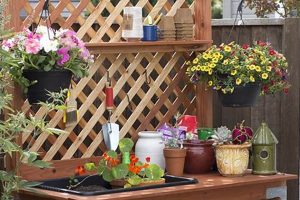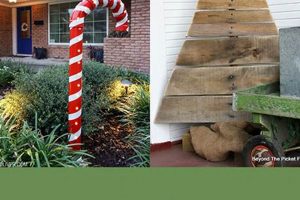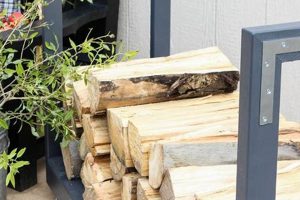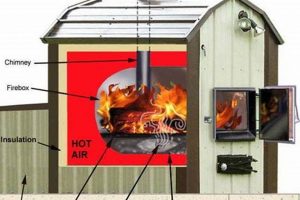A self-constructed open-air bathing structure provides a private area for rinsing off outdoors. This type of amenity typically involves building a walled or screened-off space adjacent to a house, pool, or garden. The purpose is to offer a convenient place to shower, especially after swimming, gardening, or other outdoor activities, without tracking dirt and moisture inside the main dwelling.
Constructing such a facility offers several advantages. It enhances outdoor living by providing a refreshing space to cool off and clean up. Moreover, it adds value to a property by creating an attractive and functional outdoor feature. Historically, similar structures have existed in various cultures, often serving as practical solutions for hygiene or as elements of garden design. The modern iteration emphasizes convenience, aesthetics, and personalization.
The following discussion will explore key aspects of designing and building a personalized outdoor bathing area, including material selection, construction techniques, plumbing considerations, and privacy solutions. Further sections will delve into specific design ideas and practical tips for creating a durable and aesthetically pleasing structure.
Essential Construction Guidance
The subsequent recommendations offer crucial insights for successfully creating a personalized open-air bathing space. These guidelines focus on ensuring structural integrity, privacy, and functionality.
Tip 1: Material Selection: Choose weather-resistant materials such as cedar, redwood, or composite decking. These materials withstand moisture and resist decay, extending the structure’s lifespan. Consider using pressure-treated lumber for the frame for added protection against the elements.
Tip 2: Foundation Stability: Ensure a solid and level foundation for the structure. A concrete pad, gravel base, or properly installed deck footing will prevent shifting and settling over time. A stable foundation is critical for the longevity and safety of the installation.
Tip 3: Plumbing Integration: Plan the plumbing system carefully, considering both hot and cold water supply lines. Use appropriate piping materials like PEX or copper, and ensure proper drainage to prevent water accumulation and potential damage. Consult local building codes for compliance requirements.
Tip 4: Privacy Considerations: Implement strategies to ensure adequate privacy. Solid walls, lattice panels, or strategically placed vegetation can provide seclusion. Evaluate the surrounding environment and adjust the design accordingly to minimize visibility.
Tip 5: Drainage Solutions: Establish an effective drainage system to prevent water pooling and soil erosion. A gravel bed, French drain, or connection to an existing drainage system can effectively manage water runoff. Proper drainage is essential to avoid long-term issues.
Tip 6: Structural Integrity: Reinforce the structure with proper bracing and connections. Use screws and bolts designed for outdoor use to ensure a secure and lasting assembly. Adequate bracing will withstand wind and other external forces.
Tip 7: Code Compliance: Verify all local building codes and regulations before commencing construction. Obtain necessary permits and adhere to requirements for plumbing, electrical, and structural aspects. Compliance ensures safety and prevents legal complications.
Adherence to these guidelines will significantly contribute to a robust, functional, and aesthetically pleasing outdoor bathing area. Prioritizing durability, privacy, and code compliance ensures a successful and enduring project.
The following section will address common design considerations and aesthetic enhancements, providing further guidance for customization and personalization.
1. Privacy Screening
The effective implementation of privacy screening is a critical component in the successful construction of a self-built open-air bathing area. The primary function of such an enclosure is to provide a secluded space for personal hygiene activities conducted outdoors. Consequently, the absence of adequate privacy screening negates the fundamental purpose of the enclosure. For instance, a structure built with insufficient wall height or inappropriate materials, such as translucent plastic, will fail to provide the necessary concealment, rendering it functionally useless and potentially creating legal or social complications.
Various methods can achieve adequate screening, each with its own set of advantages and disadvantages. Solid walls offer maximum privacy but can also create a sense of confinement and obstruct natural light and ventilation. Lattice panels, while providing some visual barrier, allow for airflow and a more open feel. Strategically planted vegetation can serve as a natural screen, offering aesthetic appeal and environmental benefits. The selection of the appropriate method depends on factors such as the desired level of privacy, budget constraints, aesthetic preferences, and site conditions. For example, a tightly spaced bamboo screen may be ideal for a small urban yard, while a more substantial wooden fence might be better suited for a larger, more rural property. Improper implementation can cause issues; inadequate spacing between planks in a wood screen can compromise privacy.
In summary, privacy screening is inextricably linked to the functionality and desirability of an outdoor bathing area. Its appropriate design and construction are not merely aesthetic considerations but rather essential components that determine the usability and value of the structure. Challenges include balancing privacy with ventilation and natural light, selecting appropriate materials, and ensuring structural stability. Successfully addressing these challenges results in a functional and private outdoor space.
2. Material Durability
Material durability is a paramount consideration in the design and construction of a self-built open-air bathing structure. The outdoor environment exposes the structure to a range of conditions that can degrade materials over time. Selecting durable materials directly impacts the longevity, safety, and overall value of the finished project.
- Resistance to Moisture and Decay
Materials used in such structures are consistently exposed to moisture, both from the shower itself and from environmental sources like rain and humidity. Wood species naturally resistant to decay, such as cedar and redwood, are often preferred. These woods contain oils and compounds that inhibit fungal growth and insect infestation. For example, using untreated pine for framing will result in rot and structural failure within a few years, whereas cedar can last for decades with proper maintenance. Chemical treatments, like pressure-treating lumber, can also enhance resistance but may present environmental or health concerns.
- Weather Resistance and UV Degradation
Exposure to sunlight, especially ultraviolet (UV) radiation, can degrade many materials. Plastics, for example, can become brittle and discolored over time. Choosing materials with inherent UV resistance or applying protective coatings is essential. Composite decking materials, which blend wood fibers and plastics, offer enhanced resistance to both moisture and UV degradation compared to natural wood alone. However, the quality and composition of composite materials vary, so selecting reputable brands with established performance records is crucial.
- Structural Integrity and Load-Bearing Capacity
The materials used for framing and structural components must possess adequate strength to support the weight of the structure and withstand wind loads. Pressure-treated lumber is commonly used for framing due to its strength and resistance to decay. Steel or aluminum can also be used for framing, offering even greater strength and durability, but at a higher cost and with potential challenges in terms of workability. The selection of structural materials must be based on careful consideration of local building codes and anticipated environmental stresses.
- Maintenance Requirements
Even durable materials require some level of maintenance to ensure their longevity. Regular cleaning, sealing, and staining can help protect wood from moisture and UV damage. The frequency of maintenance depends on the specific material and the severity of the environmental conditions. For example, cedar siding may require restaining every few years, while composite decking may only need occasional cleaning. Selecting materials with lower maintenance requirements can reduce the long-term cost and effort associated with the structure.
The selection of materials for a self-built open-air bathing structure is a complex decision that requires balancing durability, cost, aesthetics, and maintenance requirements. By carefully considering these factors and selecting appropriate materials, it is possible to create a structure that provides years of enjoyment and adds value to the property.
3. Plumbing Integration
The successful realization of a self-constructed open-air bathing facility hinges critically on the effective integration of plumbing systems. This integration directly impacts functionality, water usage efficiency, and adherence to local regulatory standards. Without proper plumbing, the enclosure is rendered unusable, lacking the essential water supply and drainage mechanisms required for showering. For instance, a structure erected without a connection to a potable water source would necessitate manual water hauling, negating the convenience sought through such a construction. Conversely, inadequate drainage can lead to water accumulation, promoting unsanitary conditions and potential structural damage from moisture.
Several practical considerations arise during plumbing integration. Selecting appropriate piping materials, such as PEX or copper, is crucial for durability and resistance to environmental factors. Proper pipe insulation is essential in regions subject to freezing temperatures to prevent burst pipes. Furthermore, the installation of backflow preventers safeguards the potable water supply from contamination. Real-world examples of improper plumbing installation include instances where inadequate pipe sizing resulted in reduced water pressure, or where the absence of a drain trap allowed sewer gases to enter the enclosure. Careful planning and adherence to plumbing codes can mitigate these risks, ensuring a safe and functional water system.
In conclusion, plumbing integration represents an indispensable aspect of creating a functional open-air bathing structure. Its importance extends beyond mere water conveyance, encompassing considerations of safety, efficiency, and regulatory compliance. Challenges associated with this integration, such as material selection and adherence to codes, necessitate careful planning and execution. Proper plumbing ensures the longevity and usability of the enclosure, while inadequate attention to these details can lead to costly repairs and potential health hazards. The integration stands as an integral element within the overall construction process.
4. Foundation Stability
Foundation stability represents a critical element in the successful construction and longevity of any self-built open-air bathing structure. Its importance stems from the fact that a stable foundation ensures the structural integrity of the enclosure, preventing shifting, settling, and potential collapse over time. A compromised foundation can lead to a range of problems, from cosmetic issues like misaligned walls to serious safety hazards.
- Load Distribution and Weight Bearing
The primary role of a foundation is to distribute the weight of the structure evenly across the underlying soil. Inadequate load distribution can result in concentrated stress points, leading to soil compaction and foundation settlement. For example, a shower enclosure built on a thin concrete slab placed directly on unprepared soil will likely crack and sink over time, particularly if the soil is prone to expansion or contraction due to moisture changes. Proper foundation design considers the soil type, drainage characteristics, and anticipated load to ensure long-term stability.
- Prevention of Frost Heave
In climates subject to freezing temperatures, the phenomenon of frost heave can significantly impact foundation stability. Frost heave occurs when water in the soil freezes and expands, exerting upward pressure on the foundation. If the foundation is not properly designed to resist this force, it can crack or lift, causing structural damage. Strategies for preventing frost heave include using a deep foundation that extends below the frost line or incorporating a layer of gravel to promote drainage and reduce moisture content in the soil.
- Mitigation of Soil Erosion and Water Damage
A properly constructed foundation can also help to mitigate soil erosion and water damage. Without a solid foundation, water runoff from the shower or rain can erode the soil around the structure, undermining its support. This is particularly problematic on sloped sites or in areas with poor drainage. A well-designed foundation incorporates drainage features to divert water away from the structure and prevent soil erosion.
- Ensuring Structural Integrity and Safety
Ultimately, foundation stability is essential for ensuring the overall structural integrity and safety of the outdoor shower enclosure. A stable foundation provides a solid base for the walls, plumbing, and other components, preventing them from shifting or collapsing. This not only protects the structure from damage but also ensures the safety of individuals using the shower. Neglecting foundation stability can result in a hazardous environment and costly repairs.
The connection between foundation stability and a self-built open-air bathing area is undeniable. A stable foundation serves as the bedrock upon which the entire structure rests, influencing its longevity, safety, and overall functionality. While seemingly less glamorous than aesthetic design elements, the foundation is the most important factor, by far.
5. Drainage System
A functioning drainage system is essential for the successful operation of a self-constructed open-air bathing area. It prevents water accumulation, mitigates soil erosion, and maintains sanitary conditions around the structure. The absence of an effective drainage solution compromises the usability and longevity of the amenity.
- Water Runoff Management
The primary role of a drainage system is to efficiently manage water runoff from the shower enclosure. Uncontrolled water flow can lead to soil erosion, the creation of mud puddles, and potential damage to surrounding landscaping. A properly designed system captures shower water and directs it away from the immediate area, preventing these negative consequences. For instance, a gravel bed beneath the shower floor allows water to percolate into the soil, while a French drain system channels excess water to a designated drainage area. Improper management can create breeding grounds for mosquitos.
- Soil Erosion Prevention
Shower water contains soap and other chemicals that can negatively impact soil health and stability. Continuous exposure to this water can erode the topsoil, leading to plant damage and structural instability of the enclosure itself. A drainage system that incorporates filtration or dispersal mechanisms can help to mitigate these effects. A simple example is a layer of landscape fabric beneath the gravel bed, preventing soil particles from washing away and clogging the drainage system. Erosion can undermine the stability of the structure itself over time, making it vital to have solid drainage.
- Sanitary Condition Maintenance
Standing water around the enclosure creates unsanitary conditions, promoting the growth of mold, mildew, and bacteria. A well-designed drainage system prevents water accumulation, thereby minimizing the risk of these health hazards. A properly sloped shower floor and an efficient drain are essential components of such a system. Regular cleaning and maintenance are also necessary to prevent clogs and ensure proper drainage. The lack of appropriate planning creates health hazards that make the entire structure unsanitary.
- Compliance with Local Regulations
Many municipalities have regulations regarding wastewater disposal, including shower water. A drainage system must comply with these regulations to avoid legal issues and environmental damage. This may involve connecting the shower drain to a septic system or sewer line, or utilizing a graywater system for irrigation purposes. Compliance ensures that the disposal system minimizes its impact on the environment and local waterways. Ignoring compliance can create hefty fines and legal battles with the local municipality.
In summary, a functional drainage system is indispensable for the long-term viability of an open-air bathing space. These facets highlight not just the functional importance, but the environmental considerations and regulatory compliance associated with its design and execution. Neglecting drainage can create environmental problems, health concerns, and legal liabilities. Therefore, careful planning, design, and implementation are essential to ensure a safe, sanitary, and compliant outdoor amenity.
6. Structural Support
The provision of adequate structural support is fundamental to the successful construction of a self-built open-air bathing enclosure. Structural support dictates the ability of the enclosure to withstand environmental stressors such as wind, snow load, and soil movement, thereby ensuring the safety and longevity of the installation. Absent sufficient support, the structure is susceptible to collapse, posing a significant safety hazard and rendering the investment impractical. For instance, an enclosure built with inadequate framing members may buckle under wind pressure, potentially causing injury to users or damage to adjacent property.
Various methods exist to enhance structural integrity. Proper selection of framing materials, such as pressure-treated lumber or steel, is crucial. Furthermore, the use of appropriate connection techniques, including bolts, screws, and adhesives designed for outdoor use, contributes to a robust assembly. Diagonally bracing corners and reinforcing load-bearing members are essential for resisting lateral forces. In regions prone to seismic activity, additional reinforcement measures may be required to ensure compliance with local building codes and to mitigate the risk of structural failure. Consider, for example, the failure of poorly constructed sheds during storms due to the omission of corner bracing, highlighting the practical importance of robust framing techniques.
In conclusion, structural support is an indispensable attribute of a durable and safe open-air bathing structure. Challenges include selecting appropriate materials, implementing effective connection methods, and adhering to relevant building codes. Prioritizing structural integrity ensures the longevity and safety of the structure, preventing costly repairs and potential hazards. The importance cant be overstated, given structural inadequacies often translate to unsafe structures.
7. Code Compliance
Adherence to local building codes represents a non-negotiable aspect of constructing a self-built open-air bathing structure. Code compliance ensures the safety, structural integrity, and environmental compatibility of the installation. Failure to comply can result in legal penalties, required demolition of the structure, and potential safety hazards for users and neighbors. The connection between code compliance and this type of structure is one of direct cause and effect: non-compliance invariably leads to negative consequences ranging from monetary fines to complete reconstruction. Code requirements vary based on geographic location but generally address structural stability, plumbing regulations, electrical safety (if applicable), and wastewater disposal.
Specific examples of code-related issues in such projects include improper wastewater drainage, which can lead to soil contamination and violation of environmental regulations. Electrical installations for lighting or water heating must adhere to strict safety standards to prevent electrocution hazards. Structural requirements dictate the minimum size and spacing of framing members to withstand wind and snow loads, preventing collapse. Furthermore, zoning regulations may impose restrictions on the size, location, and visibility of the structure to maintain neighborhood aesthetics and property values. The practical significance of understanding these codes lies in the ability to avoid costly mistakes, ensure user safety, and protect the environment.
In summary, code compliance is an indispensable consideration in any self-built open-air bathing project. Navigating the complexities of local regulations requires careful research, consultation with building officials, and meticulous adherence to established standards. Challenges include interpreting ambiguous code language and adapting designs to meet specific requirements. Ultimately, prioritizing code compliance ensures a safe, legal, and sustainable addition to the property, avoiding legal action, financial burdens, and potential safety risks.
Frequently Asked Questions
The following section addresses common inquiries regarding the construction of a self-built outdoor bathing area. The information provided aims to clarify critical aspects of design, materials, and regulatory compliance.
Question 1: Is a permit required for building this type of structure?
The necessity of a permit depends on local building codes and zoning regulations. Most municipalities require permits for structures exceeding a certain size or involving plumbing modifications. Contacting the local building department is crucial to ascertain specific permit requirements.
Question 2: What are the recommended materials for ensuring privacy?
Suitable materials for privacy screening include solid wood fencing, lattice panels with vegetation, and composite privacy screens. Material selection should consider durability, weather resistance, and aesthetic preferences. Height restrictions imposed by local codes should also be considered.
Question 3: How should drainage be addressed to prevent water damage?
Effective drainage solutions include a gravel base beneath the enclosure, a French drain system, or connection to an existing drainage system. Proper grading and slope are essential to direct water away from the foundation and prevent soil erosion.
Question 4: What are the considerations for winterizing the plumbing system?
In climates prone to freezing temperatures, the plumbing system must be winterized to prevent burst pipes. This involves draining the water lines, insulating exposed pipes, and installing shut-off valves. Consulting a qualified plumber is recommended for complex winterization procedures.
Question 5: What are the potential liabilities associated with such a structure?
Potential liabilities include injuries sustained within the enclosure due to structural defects or slippery surfaces. Maintaining proper maintenance and ensuring compliance with building codes are essential to mitigate these risks. Adequate insurance coverage is recommended.
Question 6: How can the environmental impact of the shower be minimized?
The environmental impact can be minimized by using water-efficient showerheads, employing graywater systems for irrigation, and selecting eco-friendly building materials. Proper disposal of wastewater is also crucial to prevent soil and water contamination.
In conclusion, the successful construction of a self-built open-air bathing area necessitates careful planning, adherence to building codes, and consideration of safety and environmental factors. Addressing these frequently asked questions can help to ensure a functional, safe, and sustainable installation.
The subsequent section will delve into specific design ideas and customization options for creating a unique outdoor bathing space.
diy outdoor shower enclosure
This exploration has addressed the critical aspects of constructing a self-built open-air bathing facility. Key points encompassed material selection, foundation stability, plumbing integration, drainage solutions, structural support, and adherence to local building codes. The intention was to underscore the importance of meticulous planning and execution to ensure a safe, functional, and code-compliant structure. Moreover, the information presented has emphasized the potential pitfalls associated with neglecting these fundamental considerations.
Careful consideration of these factors is paramount for anyone undertaking such a project. The creation of this amenity requires a commitment to detail and a thorough understanding of the principles outlined. The significance lies not only in providing an outdoor bathing space, but also in ensuring the long-term integrity and safety of the installation. Thoughtful design and execution will result in a valuable addition to the property. Careful execution will translate to long-term value.







